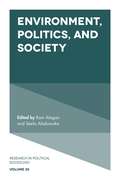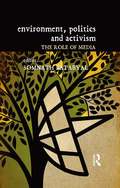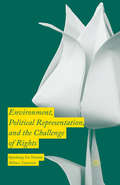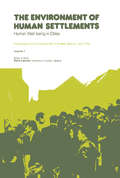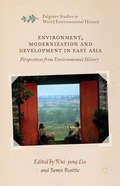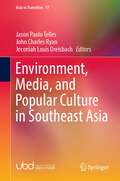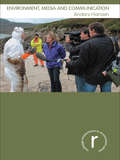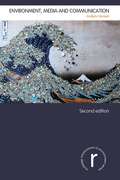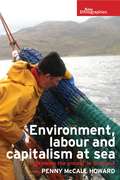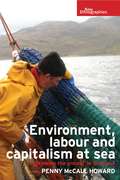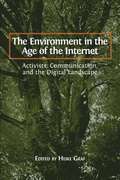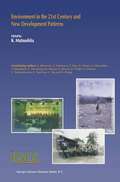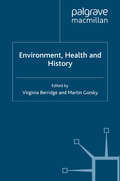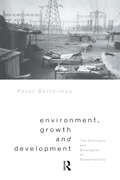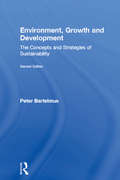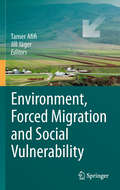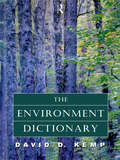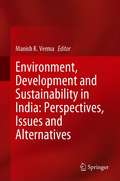- Table View
- List View
Environment, Politics and Society (Research in Political Sociology #25)
by Ramakrishnan Alagan Seela AladuwakaThis special volume of Research in Political Sociology addresses the interconnectivity of environment, politics and society. Contributors engage with critical topics such as water resource management, climate change, civil rights, poverty and social inequality, green transportation and brain drain, and examines these issues internationally in North America, South America, Asia and the Middle East. In the midst of vigorous discussions on environmental sustainability and crises that make global communities more vulnerable than ever before, on local, regional, and global scales, the chapters in this volume offer a much-needed dialogue, and will be of interest to politicians, policymakers and scientists as well as academic researchers.
Environment, Politics and Society (Research in Political Sociology #25)
by Ramakrishnan Alagan Seela AladuwakaThis special volume of Research in Political Sociology addresses the interconnectivity of environment, politics and society. Contributors engage with critical topics such as water resource management, climate change, civil rights, poverty and social inequality, green transportation and brain drain, and examines these issues internationally in North America, South America, Asia and the Middle East. In the midst of vigorous discussions on environmental sustainability and crises that make global communities more vulnerable than ever before, on local, regional, and global scales, the chapters in this volume offer a much-needed dialogue, and will be of interest to politicians, policymakers and scientists as well as academic researchers.
Environment, Politics and Activism: The Role of Media
by Somnath BatabyalThis book examines the role of the media in environmental politics and activism in the 21st century. It highlights how politics is mediated in myriad ways through newspapers and news channels, through mobile telephony and through social networking sites. Further, it shows how the media creates and influences relevant discourses, builds campaigns and awareness, and adopts and discards issues. With a range of perspectives on issues of environmental justice and equity, the volume scrutinizes how the media discourse on environment shapes our politics, and the role of international politics, finance, youth, newspapers, magazines and 24-hour television. Bringing together academics, activists and media persons, this highly topical book will serve as significant reading for researchers and scholars of development studies and media studies, as well as policymakers, NGOs and environmental campaigners.
Environment, Politics and Activism: The Role of Media
by Somnath BatabyalThis book examines the role of the media in environmental politics and activism in the 21st century. It highlights how politics is mediated in myriad ways through newspapers and news channels, through mobile telephony and through social networking sites. Further, it shows how the media creates and influences relevant discourses, builds campaigns and awareness, and adopts and discards issues. With a range of perspectives on issues of environmental justice and equity, the volume scrutinizes how the media discourse on environment shapes our politics, and the role of international politics, finance, youth, newspapers, magazines and 24-hour television. Bringing together academics, activists and media persons, this highly topical book will serve as significant reading for researchers and scholars of development studies and media studies, as well as policymakers, NGOs and environmental campaigners.
Environment, Political Representation and the Challenge of Rights: Speaking for Nature
by Mihnea TanasescuTanasescu examines the rights of nature in terms of its constituent parts. Besides offering a thorough theoretical grounding, the book gives a first detailed overview of the actual cases of rights for nature so far. This is the first comprehensive treatment of the rights of nature to date, both analytically and in terms of actual cases.
The Environment of Human Settlements Human Well-Being in Cities: Proceedings of the Conference Held in Brussels, Belgium, April 1976
by P. Laconte G. Epstein J. E. GibsonThe Environment of Human Settlements: Human Well-Being in Cities, Volume 1 contains the proceedings of the Conference on the Environment of Human Settlements: Human Well-Being in Cities, held in Brussels, Belgium, in April 1976. The papers focus on the environmental implications of human settlements, with emphasis on the well-being of people living in cities. This volume is comprised of 31 chapters organized around four themes: modern technology for cities of today; decision-making for human well-being in cities (including political, legal and economic considerations); urban and land-use planning; and design as a component in urban policy. Ontario's resource recovery program is described, and interstate highway interchange communities as sites of future settlements are considered. The effects of highway noise in residential communities are also discussed, along with the role of remote sensing in habitat; financial and technical management for human settlements; human settlements as sociotechnical-economic processes; how to optimize urban density; and quantitative landscape evaluation for open space planning. This book will be of interest to engineers, scientists, and decision-makers concerned with local, national, regional, and global environmental problems related to human settlements.
Environment, Modernization and Development in East Asia: Perspectives from Environmental History (Palgrave Studies in World Environmental History)
by Ts’ui-Jung LiuEnvironment, Modernization and Development in East Asia critically examines modernization's long-term environmental history. It suggests new frameworks for understanding as inter-related processes environmental, social, and economic change across China and Japan.
Environment, Media, and Popular Culture in Southeast Asia (Asia in Transition #17)
by Jason Paolo Telles John Charles Ryan Jeconiah Louis DreisbachThis book addresses the increasingly important subject of ecomedia by critically examining the interconnections between environment, ecology, media forms, and popular culture in the Southeast Asian region, exploring methods such as textual analysis, thematic analysis, content analysis, participatory ethnography, auto ethnography, and semi-structured interviewing. It is divided into four sections: I. Activism, Environment, and Indigeneity; II. Political, Ecologies and Urban Spaces; III. Narratives, Discourses, and Aesthetics; and IV. Imperialism, Nationalism, and Islands, covering topics such as broadcast media (radio and TV) and the environment; green cinema and ecodocumentaries, ecodigital art, digital environmental literature. It is of great interest to researchers, students, practitioners and scholars working in the area of humanities, media, communications, cultural studies, environmental humanities, environmental studies, and sustainability.
Environment, Media and Communication
by Anders HansenCommunication about ‘the environment’ in and through a broad array of news, advertising, art and entertainment media is one of the major sources of public and political understanding of definitions, issues and problems associated with the environment. Environment, Media and Communication examines the social, cultural and political roles of the media as a public arena for images, representations, definitions and controversy regarding the environment. The book starts by discussing and outlining a framework for analyzing media and communication roles in the emergence of the environment and environmental problems as issues for public and political concern. It proceeds to examine who and what drives the public agenda on environmental issues, addressing questions about how governments, scientists, experts, pressure groups and other stakeholders have sought to use traditional as well as newer media for promoting their definitions of the key issues. The media are not merely an open public arena or stage, but rather themselves a key gate-keeper and influence in the process of communicating about the environment: the role of news values, organizational arrangements and professional practices, are thus examined next. Recognizing the importance of wider popular culture narratives to public understanding and communication about the environment and nature, the book proceeds with a discussion of the messages and moral tales communicated about the environment, science and nature in a range of media, including film and advertising media. It shows how this wider context provides important clues to understanding the successes and failures of selected environmental issues or campaigns. The book finishes with an examination of the key approaches and models used for understanding how the media influence and interact with public opinion and political decision-making on environmental issues. Offering a comprehensive introduction to theoretical approaches and models for the study of media and communication roles regarding the environment, and drawing on empirical research evidence and examples from Europe, America, Australia and Asia, the book will be of interest to students in media/communication studies, geography, environmental studies, political science and sociology as wll as to environmental professionals and activists.
Environment, Media and Communication
by Anders HansenCommunication about ‘the environment’ in and through a broad array of news, advertising, art and entertainment media is one of the major sources of public and political understanding of definitions, issues and problems associated with the environment. Environment, Media and Communication examines the social, cultural and political roles of the media as a public arena for images, representations, definitions and controversy regarding the environment. The book starts by discussing and outlining a framework for analyzing media and communication roles in the emergence of the environment and environmental problems as issues for public and political concern. It proceeds to examine who and what drives the public agenda on environmental issues, addressing questions about how governments, scientists, experts, pressure groups and other stakeholders have sought to use traditional as well as newer media for promoting their definitions of the key issues. The media are not merely an open public arena or stage, but rather themselves a key gate-keeper and influence in the process of communicating about the environment: the role of news values, organizational arrangements and professional practices, are thus examined next. Recognizing the importance of wider popular culture narratives to public understanding and communication about the environment and nature, the book proceeds with a discussion of the messages and moral tales communicated about the environment, science and nature in a range of media, including film and advertising media. It shows how this wider context provides important clues to understanding the successes and failures of selected environmental issues or campaigns. The book finishes with an examination of the key approaches and models used for understanding how the media influence and interact with public opinion and political decision-making on environmental issues. Offering a comprehensive introduction to theoretical approaches and models for the study of media and communication roles regarding the environment, and drawing on empirical research evidence and examples from Europe, America, Australia and Asia, the book will be of interest to students in media/communication studies, geography, environmental studies, political science and sociology as wll as to environmental professionals and activists.
Environment, Media and Communication (Routledge Introductions to Environment: Environment and Society Texts)
by Anders HansenMedia and communication processes are central to how we come to know about and make sense of our environment and to the ways in which environmental concerns are generated, elaborated, manipulated and contested. The second edition of Environment, Media and Communication builds on the first edition’s framework for analysing and understanding media and communication roles in the politics of the environment. It draws on the significant and continuing growth and advances in the field of environmental communication research to show the increasing diversification and complexity of environmental communication. The book highlights the persistent urgency of analysing and understanding how communication about the environment is being influenced and manipulated, with implications for how and indeed whether environmental challenges are being addressed and dealt with. Since the first edition, changes in media organisations, news media and environmental journalism have continued apace, but – perhaps more significantly – the media technologies and the media and communications landscape have evolved profoundly with the continued rise of digital and social media. Such changes have gone hand in hand with, and often facilitated, enabled and enhanced shifting balances of power in the politics of the environment. There is thus a greater need than ever to analyse and understand the roles of mediated public communication about the environment, and to ask critical questions about who/what benefits and who/what is adversely affected by such processes. This book will be of interest to students in media/communication studies, geography, environmental studies, political science and sociology as well as to environmental professionals and activists.
Environment, labour and capitalism at sea: Working the ground' in Scotland (New Ethnographies)
by Penny McCall HowardThis book combines phenomenology and political economy to offer new approaches for analyses of human-environment relations and technologies. It contributes to the social studies of fisheries through an analysis of how fishing practices and social relations are shaped by political economy.
Environment, labour and capitalism at sea: Working the ground' in Scotland (New Ethnographies)
by Penny McCall HowardThis book explores how fishers make the sea productive through their labour, using technologies ranging from wooden boats to digital GPS plotters to create familiar places in a seemingly hostile environment. It shows how their lives are affected by capitalist forces in the markets they sell to, forces that shape even the relations between fishers on the same boat. Fishers frequently have to make impossible choices between safe seamanship and staying afloat economically, and the book describes the human impact of the high rate of deaths in the fishing industry. The book makes a unique contribution to understanding human-environment relations, examining the places fishers create and name at sea, as well as technologies and navigation practices. It combines phenomenology and political economy to offer new approaches for analyses of human-environment relations and technologies.
Environment in the Balance: The Green Movement And The Supreme Court
by Jonathan Z. CannonDoes the green movement remain a transformative force in American life? In Environment in the Balance Jonathan Cannon interprets a wide range of U.S. Supreme Court decisions over four decades and explores the current ferment among activists, to gauge the practical and cultural impact of environmentalism and its future prospects.
Environment in the Balance: The Green Movement And The Supreme Court
by Jonathan Z. CannonDoes the green movement remain a transformative force in American life? In Environment in the Balance Jonathan Cannon interprets a wide range of U.S. Supreme Court decisions over four decades and explores the current ferment among activists, to gauge the practical and cultural impact of environmentalism and its future prospects.
The Environment in the Age of the Internet: Activists, Communication, and the Digital Landscape (PDF)
by Heike GrafHow do we talk about the environment? Does this communication reveal and construct meaning? Is the environment expressed and foregrounded in the new landscape of digital media? The Environment in the Age of the Internet is an interdisciplinary collection that draws together research and answers from media and communication studies, social sciences, modern history, and folklore studies. Edited by Heike Graf, its focus is on the communicative approaches taken by different groups to ecological issues, shedding light on how these groups tell their distinctive stories of "the environment". This book draws on case studies from around the world and focuses on activists of radically different kinds: protestors against pulp mills in South America, resistance to mining in the Sámi region of Sweden, the struggles of indigenous peoples from the Arctic to the Amazon, gardening bloggers in northern Europe, and neo-Nazi environmentalists in Germany. Each case is examined in relation to its multifaceted media coverage, mainstream and digital, professional and amateur. Stories are told within a context; examining the "what" and "how" of these environmental stories demonstrates how contexts determine communication, and how communication raises and shapes awareness. These issues have never been more urgent, this work never more timely. The Environment in the Age of the Internet is essential reading for everyone interested in how humans relate to their environment in the digital age.
The Environment in the Age of the Internet: Activists, Communication, and the Digital Landscape
by Heike GrafHow do we talk about the environment? Does this communication reveal and construct meaning? Is the environment expressed and foregrounded in the new landscape of digital media? The Environment in the Age of the Internet is an interdisciplinary collection that draws together research and answers from media and communication studies, social sciences, modern history, and folklore studies. Edited by Heike Graf, its focus is on the communicative approaches taken by different groups to ecological issues, shedding light on how these groups tell their distinctive stories of "the environment". This book draws on case studies from around the world and focuses on activists of radically different kinds: protestors against pulp mills in South America, resistance to mining in the Sámi region of Sweden, the struggles of indigenous peoples from the Arctic to the Amazon, gardening bloggers in northern Europe, and neo-Nazi environmentalists in Germany. Each case is examined in relation to its multifaceted media coverage, mainstream and digital, professional and amateur. Stories are told within a context; examining the "what" and "how" of these environmental stories demonstrates how contexts determine communication, and how communication raises and shapes awareness. These issues have never been more urgent, this work never more timely. The Environment in the Age of the Internet is essential reading for everyone interested in how humans relate to their environment in the digital age.
Environment in the 21st Century and New Development Patterns (Institute for Global Environmental Strategies #2)
by Randal HeltenEconomic growth after World War II was made possible through dramatic increases in the use of material resources and energy. It is apparent that current development patterns followed by industrialized countries are causing serious environmental problems and that they are neither ecologically nor socially sustainable. In recent years, many Asian developing countries, which have suffered from poverty for decades, are experiencing high rates of economic growth by introducing material-intensive production and consumption patterns. The globalization trends magnify on a global scale the problems associated with current development patterns. How can we transform existing economic and social systems into more environmentally benign and sustainable ones? This book presents a number of issues that must be considered whn discussing new development patterns, which are environmentally friendly and socially fair. It covers concepts of new development patterns, new energy and water supply, sustainable agriculture, information technology and environment, information disclosure and poverty alleviation. Audience: This volume will be of interest to those who are involved in innovative interdisciplinary policy studies on environment and development, particularly in Asia and the Pacific region. Also those who are interested in realizing sustainable development through agriculture, water supply, information technology, chemical industry and sustainability issues in China and India.
Environment, Health and History
by Virginia Berridge Martin GorskyThe environment is currently a matter of international public and academic concern, but is often considered separately from health issues. This book brings together work from environmental and health historians to conceptualise the connection between environment and health at different times and in different geographical locations.
Environment, Growth and Development: The Concepts and Strategies of Sustainability
by Peter BartelmusFirst Published in 2004. Routledge is an imprint of Taylor & Francis, an informa company.
Environment, Growth and Development: The Concepts and Strategies of Sustainability
by Peter BartelmusFirst Published in 2004. Routledge is an imprint of Taylor & Francis, an informa company.
Environment, Forced Migration and Social Vulnerability
by Tamer Afifi Jill JägerThis book is one of the outputs of the conference on ‘Environmental Change, Forced Migration, and Social Vulnerability’ (EFMSV) held in Bonn in October 2008. Migration is one of the oldest adaptation measures of humanity. Indeed, without migration the multitude of civilizations and interactions between them – peaceful and otherwise – would be hard to imagine. The United Nations (UN)-led global dialogue on migration is a clear sign that governments and the specialized UN agencies and bodies have recognized the need to view, govern, manage, and facilitate migration; to mitigate its negative effects; and to capitalize on the positive ones. It is a common expectation among experts that environmentally induced migration will further increase in the decades to come. Hence, next to the political, economic, ethnic, social, financial, humanitarian, and security aspects of migration, the environmental component should urgently be considered in the ongoing international dialogue on migration. This need is also a challenge. Without appropriate scientific knowledge, assessment, definitions, and classifications, the intergovernmental frameworks would not be able to deal with these complex phenomena. The Five-Pronged-Approach as formulated by the United Nations University (UNU) may serve as a framework to identify the additional dimensions of this challenge next to – and actually simultaneously with – the scientific one.
The Environment Dictionary
by David KempThe Environment Dictionary provides an essential source of information on all aspects of the environment. It includes all the basic scientific terms and concepts along with socio-economic, cultural, historical and political elements which impact on the environment. This dictionary provides the interdisciplinary approach required to understand environmental issues worldwide. Designed for a wide range of readers, the dictionary is up-to-date, easy to read and to reference and clearly and attractively presented. Selected environmental issues which have particular importance are treated in greater depth through a series of boxed case studies. A wide range of maps, diagrams, figures and photos illustrate the texts and extensie cross-referencing between entries ensures readers can build on their knowledge. References and further reading sections are drawn from a wide range of accessible sources - from newspaper articles and popular magazines to academic texts and journals and provide easy access to further study and development of readers' specific interests.
The Environment Dictionary
by David KempThe Environment Dictionary provides an essential source of information on all aspects of the environment. It includes all the basic scientific terms and concepts along with socio-economic, cultural, historical and political elements which impact on the environment. This dictionary provides the interdisciplinary approach required to understand environmental issues worldwide. Designed for a wide range of readers, the dictionary is up-to-date, easy to read and to reference and clearly and attractively presented. Selected environmental issues which have particular importance are treated in greater depth through a series of boxed case studies. A wide range of maps, diagrams, figures and photos illustrate the texts and extensie cross-referencing between entries ensures readers can build on their knowledge. References and further reading sections are drawn from a wide range of accessible sources - from newspaper articles and popular magazines to academic texts and journals and provide easy access to further study and development of readers' specific interests.
Environment, Development and Sustainability in India: Perspectives, Issues and Alternatives
by Manish K. VermaThis book provides a comprehensive account of asymmetric linkage in the trilogy of environment, development and sustainability and its impact on society. It examines varied perspectives and issues of development related to environmental destruction and sustainability challenges. By examining the recent trends of development and recording the dilemmas which are creating ecological imbalances, it explores some alternative ways of development to achieve sustainability. Divided into three parts, it has a broad canvass. The first section examines critically the ‘perspectives’ on ecology, practice and ethics, rural development and man–forest interaction in the metropolis. ‘Issues’ of dams, river, agricultural distress, environmental migration, eco-tourism, ecological conservation and land acquisition are assessed in part second. ‘Alternative’ means of development is explored in part third by incorporating chapters on the constructed wetland, biofuels, subsistence economy, water and traditional knowledge practice. This interdisciplinary book is of immense significance to academicians, researchers, postgraduate and graduate-level students of social sciences and environmental studies; policymakers, development practitioners and NGOs working in the area of environment and development.
